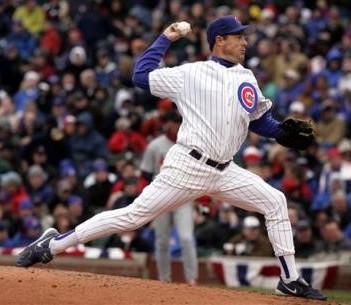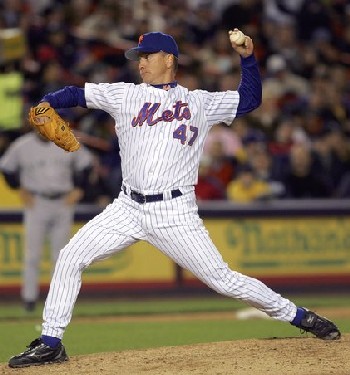Dr. Mike Marshall
My Current View
10/1/2008
Updated 10/20/2008
Anyone who has followed my work for any period of time will
know that my thinking about pitching mechanics has been influenced by
the work of Dr. Mike Marshall.
Dr. Marshall was the person who convinced me that it was a
possible to
try drive down the rate of injuries in pitchers.
However, anyone who has closely followed my work
also knows that I have become increasingly uncomfortable
with many of Dr. Mike Marshall's latest ideas. I have come to believe that, in an effort to
differentiate his work and demonstrate how much he has broken
with the establishment, Dr. Mike Marshall has gone off
the rails.
I believe that some of the things that Dr. Mike
Marshall are teaching will not only not maximize a pitcher's
velocity but might actually increase their risk of injury by
making their pitching mechanics less efficient.
Let me give you an example of what I am talking about.
Dr. Mike Marshall ON
Hip/Shoulder Separation
When I first started corresponding with Dr. Mike Marshall
back in 2005, he was one of the people who helped me understand
the importance of hip/shoulder separation to pitchers. In a reply to this question...
I took a video of my son last night and noticed that his
shoulders rotate before and much more than his hips do. Is this
correct or should the rotation of his hips lead the rotation of
his shoulders? As I visualize it, I would think that the hips
should leg the shoulders because the leading rotation of the
hips would pre-stretch the muscles of the torso, enabling them
to more powerfully rotate the shoulders.
...Dr. Mike Marshall responded
(see Dr. Mike Marshall's 2005 Q&A file
reply 805 dated 10/20/2005)...
You are correct.
Baseball pitchers should forwardly rotate their hips and leave
their shoulders behind. Then, when the hips have forwardly
rotated as far as they can, pitchers should forwardly rotate
their shoulders as far as they can.
However, Dr. Marshall evidently changed his view of
hip/shoulder separation at some point in the intervening three years.
Now, per
Dr. Mike Marshall's 2008 Q&A file
reply 721, he says...
I teach my baseball pitcher to forwardly rotate their hips,
shoulders and pitching upper arm as a unit, not separately.
I'm sorry, but this is just stupid.
Rotating the hips and shoulders together is an immature
movement pattern that most kids of any ability grow out of by 12
or 13 years of age. They do that because it's hard to get
much on your throws if you rotate your hips with your
shoulders.
If you look at photos of pretty much any major league
pitcher — including the great, injury-free ones — you will see
many
examples of
hip/shoulder separation.

Greg Maddux

Tom Glavine
If you take hip/shoulder separation out of a pitcher's
mechanics, then the result will be arm arm thrower who has to
work much harder to throw than does someone who knows how to
throw the ball with their entire body.
I believe that arm
throwers, aside from having velocity problems, face much higher
injury risks because their mechanics are fundamentally less
efficient.
I don't know why Dr. Mike Marshall is insisting on
taking the body out of the pitching motion, but in my opinion
there is no good justification for doing so. As a result, while
I still like his conditioning and pronation ideas, I no longer
regard Dr. Mike Marshall as my primary, or even major,
influence. Instead, the primary source of my beliefs is the
actual pitching mechanics of great pitchers like
Greg Maddux
and Roger
Clemens.
This Isn't (That) Personal
My change of opinion regarding Dr. Mike Marshall isn't (that) personal. Sure, I'm not thrilled that Dr. Mike Marshall has
called me "an athletic dweeb" (Dr. Mike Marshall's Q&A file
2008.721). I'm also not thrilled with what he has posted to his
web site.
For almost a year, he sent me videos of major league
baseball pitchers and asked me to analyze them. Then, he took
my analyses and convinced the St. Louis Cardinals that he knows
how to determine which baseball pitchers will injure themselves...
This is a lie.
I have never sent Dr. Marshall any videos.
I have sent him links to the
photographic
pitching mechanics analyses I did when I first started out.
I asked for his
opinion of them, but it was my work that I was asking him to
comment on.
Right now, he is bragging on Baseball Fever that he
convinces the Cardinals to sign some guy, but my kids tell me
that that guy is already on the disabled list.
This is also a lie.
For one thing, while I know a number of scouts and
others who work at the major league level, I have never worked
for the St. Louis Cardinals. The consulting I did was for
someone in a different organization. Also, the pitcher
mentioned above is on the disabled list for reasons
that aren't related to baseball.
...The Cardinals are getting a track record of hiring guys
that talk about my stuff. Brent Strom and Chris O'Leary have
never had an original thought of their own. I don’t mind that
they use my stuff, but they should admit that it is my stuff. Otherwise, it is plagiarism.
On multiple occasions I have acknowledged that my work has
been influenced by the work of Dr. Mike Marshall. That is why
on my web site I have a section entitled
Dr. Mike Marshall
101.
In general, the change in my opinion of Dr. Marshall results from my efforts to find the truth
about pitching mechanics and my growing sense that Dr. Mike
Marshall is pushing a number of ideas that simply don't hold up.
The Bottom Line
The bottom line is that, while I have learned tremendous
amounts of information from Dr. Mike Marshall, I do not think
that he is a positive force in baseball. His approach of
attacking and ridiculing pretty much everyone is simply not
constructive and only feeds his detractors who dismiss him and
his followers as a cult. What's more, ASMI has demonstrated that some of Dr. Mike
Marshall's claims simply do not hold up to deep scrutiny. I also
believe that some of his ideas, such as rotating the hips and
shoulders at the same time, simply do not make sense.
Update 10/20/2008
Dr. Mike Marshall appears to hold the ideas
that he does about the problems with
hip/shoulder separation for the following reason...
With the hip/shoulder separation forward rotation
technique that traditional baseball pitchers use, they suffer
injuries to their Oblique Internus Abdominis muscle on the glove
side of their rib cage.
The truth is that these are minor injuries that are generally due to a lack of
conditioning and are easy to recover from.
Nobody was ever forced into retirement due to problems with their obliques.
In my opinion, Dr. Mike Marshall is being overly, and needlessly, cautious
about this. Hitters often have minor problems with their obliques
when they move to a rotational swing, but they recover quickly
and don't have further problems once they condition their core. Dr. Mike Marshall
also believes...
With my hip/shoulder together forward rotation technique,
in addition to the Oblique Internus Abdominis muscle, my
baseball pitchers use the Oblique Externus Abdominis, Transverse
Abdominis and the Quadratus Lumborum muscles. These are the four
muscles that attach to the triad of hip bones and the rib cage
that rotate the shoulders relative to the hip. When my baseball pitchers
use these four powerful
hip/shoulder rotational muscles, they not only do not suffer
injuries to their Oblique Internus Abdominis muscle, but they
also rotate at considerably higher velocities.
The problem is that ASMI's data disproves this claim.
Dr. Mike Marshall's pitchers do not achieve superior rates of torso
rotation, and I think that helps to explain the velocity
problems his pitchers experience.
By design, Dr. Mike Marshall's pitchers are arm
throwers. Unfortunately, they do not use their bodies to their
full advantage.
Update 12/12/2009
While I disagree with Dr. Mike Marshall's
ideas about arm action and hip/shoulder
separation, among other things, I do think some
of his ideas have merit. As a result, and like
others that I know of, I have incorporated these
ideas into my own teaching. These good ideas
include pronation, the importance of high levels
of conditioning, and the problems with late
pitching forearm turnover and keeping the
fingers on top of the ball.
|